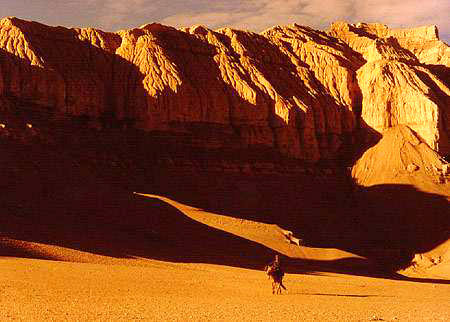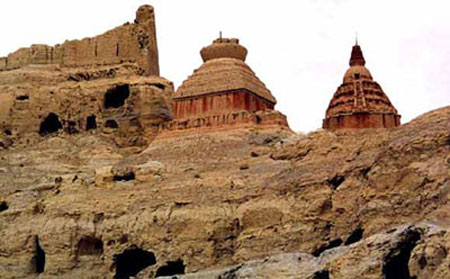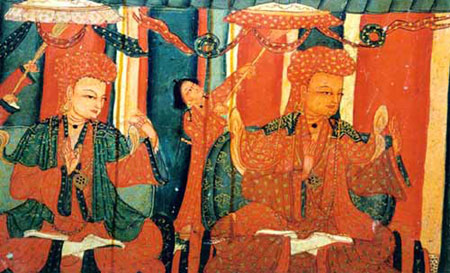Located in Dengfeng County of Henan Province, Mount Song is called the Central Mountain of the Five Sacred Mountains. It has 36 peaks and stretches 60 kilometers, composed of Mount. Taishi and Mount. Shaoshi.The highest peak is 1494 meters above sea level. Mount Song has fine natural scenery. Its 72 mountains, grouped around the peaks of Mount Shaoshi and Mount Taishi, extend for about 70 kilometers (43 miles) from east to west. Besides these mountains, there are many valleys, caves, pools and waterfalls, each of which provides the visitor with a unique and wonderful experience. The landscape is so unique that it has been given the title of 'International Geological Park' by the United Nations Educational, Scientific and Cultural Organization. (UNESCO).
The history of Mount Song is as rich and interesting as its landscape. Mount Song is on the south bank of the Yellow River in China. The nearby Shaolin Temple which is right for student tour to China is the birthplace of Zen Buddhism, and even today the temple's Forest of Pagodas named Ta Lin is the largest in China. The Zhongyue Temple is also located here, one of the earliest Taoist temples in the country. The Songyang Academy nearby was one of the four great academies of ancient China. The mountain and its vicinity are populated with Taoist and especially Buddhist monasteries. The 6th century Songyue Pagoda is also located here, as well as Tang Dynasty (618–907) pagodas within the Fawang Temple.
2. Mount.Wuyi
Mount Wuyi, lying in northern Fujian Province, covers an area of 60 square kilometers. Most of the hills here are made of red sandstone, very steep but flat on the top. The peaks and rocks of grotesque shapes are girded by clear streams and embraced by green trees and bamboo plants. The Nine-bend River, 60 kilometers long, meanders among the hills, presenting the most charming tourist route in this scenic zone.
Mount Wuyi has a long cultural history. The site of the Wuyi Palace built in the seventh century for emperors to conduct sacrificial activities remains today. It had been an important center of China's Taoism and was listed as one of the top nine Taoist Temples in the 10th century. The mountain also boasts many other cultural relics including stone inscriptions.
In 1999, Mount Wuyi entered the lists of world cultural and natural heritage.
3. Mount. Changbai
Mount Changbai is also called Buxian Mountain, meaning it divine. Mount Changbai is a dormant volcano and is the highest volcanic cone with the biggest spout in the Northeast of China. It was formed about 2 million years ago. According to the historical materials, it has broken forth three times since the sixteenth century. Mount Changbai has a unique and particular geographic conformation and intriguing sceneries. There are more than 30 wonderful scenes which are famous at home and abroad. Ascending on the top of the mountain ranges, you can realize by yourself what was described in a Chinese poem: “Looking on the top of Mount Changbai, you will feel all the other mountains are so small compared with it.” It widens your visual field, and you cannot help acclaiming it as the peak of perfection. Influenced by the vertical topography of the hilly areas, Mount Changbai forms four scenery belts from temperate zone to Frigid Zone from the foot of the mountain to the top. A colorful natural and vertical scenery belt like this is rare even in the world. There are four seasons in the mountain and the weather varies from one place to another.
4. Mount Hua
Mount Hua is located in the Shaanxi Province, about 100 kilometers east of the city of Xi'an, a destination of Silk Road tour, near the city Huayin. Mt. Hua is known as “The Number One Precipitous Mountain under Heaven”. It is one of the five sacred mountains in China.
It is famous for its natural vistas of steep and narrow paths, precipitous crags, and a high mountain range. It is home to several influential Taoist temples where emperors of past dynasties made pilgrimages, making Mt. Huashan the holy land of Taoism.
5. Mount.Tai
As the leader of the 'Five Sacred Mountains', Mt.Tai is located in the east of North China Plain and the middle of Shandong province, and its main peak, Jade Emperor Summit, is about 1532.7 meters (5,029 feet) high.
In ancient times, the first thing for an emperor to do on ascending to the throne was to climb Mt. Tai and Heaven (on the summit) and Earth (at the foot of the mountain) or their ancestors. It was said that 72 emperors of different dynasties made pilgrimages to this mountain. These special ceremonies and sacrifices earned the mountain widespread fame. In addition, many poets and literary scholars also visited the mountain to gain inspiration. The grandiose temples, the numerous stone inscriptions and stone tablets are the best testaments to these visits. Mt. Tai also played an important role in the development of Buddhism and Taoism. So in Dec.1987, it was included as "World Cultural and Natural Heritage" by UNESCO.
Besides historic relics, Mount .Tai boasts unique natural scenery too. The lofty peaks, deep valleys, spectacular waterfalls, enchanting rocks and the centuries-old pines and cypresses will undoubtedly encourage you linger with no thought of leaving. The four wonders of the mountain are Sunrises from the East, the Sunset Glow, the Sea of Clouds and the Golden Belt along the Yellow River. It would be a great pity to miss the four wonders.
But the above-mentioned mountains are not suitable for your China business tours.
You can attend China group purchase tour for saving money







































